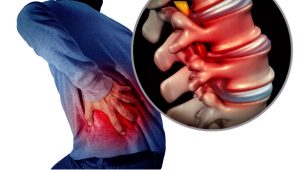
Bulging Discs: Symptoms, Causes, and Treatments
Between each of the vertebrae in your spine, there is soft tissue known as a spinal disc. These discs are meant to keep your bones from rubbing against each other and they absorb shock from any impact. These discs can become injured and compressed which causes them to bulge out. A bulging disc can cause pain and discomfort until it is addressed.
Symptoms
Commonly, bulging discs occur in the lower part of the spine. You may experience pain in your lower back due to pinched nerves. The pain you experience may worsen with movement and it can even be painful while sitting. This is because your lower back muscles put pressure on your lower spine. It’s also possible to experience muscle spasms in the lower back. It’s important to note that the pain extends beyond just the back and there are other symptoms that may indicate a bulging disc. Some people experience numbness or reduced mobility in the lower limbs, difficulty walking, and radiating pain in the legs. Sciatica is also a common symptom of a bulging disc.
Potential Causes
You may experience a bulging disc for a variety of reasons. They can be the result of injuries such as a car accident. A bulging disc may also occur after a serious back injury. These examples are the result of a sudden injury or impact. However, bulging discs can also occur after sustained activity. If you are lifting things improperly for a long time, use poor posture when sitting, or repeat the same activity (sitting/standing) for hours at a time it can cause strain on your vertebrae and lead to a bulging disc. Of course, there is a possibility to have a genetic predisposition for conditions that make bulging discs more likely.
Treatment Options
Often a bulging disc simply needs time to heal. Giving your body plenty of rest is essential. You may also benefit from physical therapy. There are plenty of exercises and stretches you can do at home in order to relieve pain and strengthen the muscles and other tissue again. In addition to physical therapy, it’s often recommended that you make a few lifestyle changes. Losing weight can reduce the strain on your lower back so your body can heal properly. It’s also helpful to switch to exercises that don’t put as much pressure on the lower back. Examples might include yoga, swimming, or walking. When you see a doctor, there are a few other treatment options they may present to you beyond physical therapy. They can provide you with medications to help with the pain and inflammation.
Addressing the Underlying Problem
When it comes to a bulging disc, you want to make sure you are taking care of the underlying problem. Many treatment options only treat the disc bulge. Too many treatments only “treat the pain.” You can treat the pain and the result of the cause, but this doesn’t necessarily solve the problem. You need to determine what caused the bulging disc, address the cause, and treat the bulge. For example, if you have a bulging disc due to a sustained activity that puts stress on your back, you should do your best to avoid or reduce that activity so you don’t continue straining yourself.
A bulging disc can be painful and uncomfortable to deal with. Understanding what caused the bulging disc and what treatment options are available might provide you with relief. If you want real results, it’s worth exploring researched-backed options that address the real issue and make use of your body’s natural capabilities of healing itself.
Do you want to find the best treatments? Click here to learn about The Nerve & Disc Institute’s revolutionary treatment options.